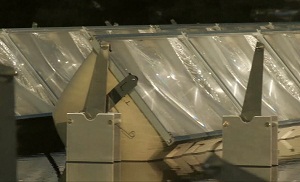Pyron Solar using water to cool and increase power of CPV arrays
 Pyron Solar is piloting it’s unique waterborne concentrating photovoltaic (CPV) system with a 20-kilowatt array in California. The system uses water to keep the high-efficiency SpectroLab multijunction Gallium Arsenide (GaAs) photovoltaic cells cooler, thus producing more electricity.
Pyron Solar is piloting it’s unique waterborne concentrating photovoltaic (CPV) system with a 20-kilowatt array in California. The system uses water to keep the high-efficiency SpectroLab multijunction Gallium Arsenide (GaAs) photovoltaic cells cooler, thus producing more electricity.
Power produced by the array, which has been operational for five months, is being used by San Deigo Gas & Electric.
“During five months of operation, the Pyron system shows continuous readings at targeted power generation levels,” the company said in a press release. “The output of the Pyron Solar system was measured delivering up to 20 watts per cell during standard operating conditions—more than 19 percent greater power per cell than any CPV manufacturer has published to date.”
“The system is floating, so the water line is below the lens itself,” said Pyron President Stephanie Rosenthal. The device uses a Fresnel lens to concentrate the sun up to 1,200 times. It is hermetically sealed within marine-grade plastics mounted on a dual-axis tracker to get the most out of the sun. Thus far the devices have stood up to heavy rains and wind, she said.
Pyron is now focused on developing a commercial version of the device, which could be adapted to automotive production line-type facilities. That and developing further pilot projects in the U.S. and abroad, according to Rosenthal. The technology could yield photovoltaic arrays that produce 1 megawatt of power per 3.1 acres of space.
“Sometime next year we plan to start on our first larger demonstration. Something between 1 and 5 megawatts,” she said.
The device is ideal for existing bodies of water in regions with high irradiance levels, those above six, Rosenthal said, places like reservoirs, ponds and lakes. Water on the lens won’t have much of an effect on the modules, and will also be used to help keep the lenses free of dust and debris.
Unlike most other manufacturers, Pyron is developing a manufacturing system intended to be mobile, Rosenthal said.
“The concept is that the manufacturing line is able to travel,” she said. “We’re not planning on shipping across the globe, so it makes sense to have your manufacturing facility nearby,”
To achieve that, Pyron has partnered with a company that has 14 facilities worldwide.
“The assembly process itself is not that difficult. We just want it precise and fast,” she said.
Image courtesy of SDG&E.



